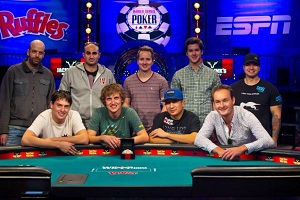 After floundering ratings and a forgettable Main Event final table in 2007, the World Series of Poker came up with a new concept for the following year that they hoped would rekindle the public’s love affair with televised poker; the November Nine. The concept seemed like a winner on paper, but in practice it has been an abject failure –at least when it comes to increasing poker’s or the WSOP’s presence.
After floundering ratings and a forgettable Main Event final table in 2007, the World Series of Poker came up with a new concept for the following year that they hoped would rekindle the public’s love affair with televised poker; the November Nine. The concept seemed like a winner on paper, but in practice it has been an abject failure –at least when it comes to increasing poker’s or the WSOP’s presence.
The idea was that once the final table of nine players had been determined the tournament would go on a prolonged hiatus of three or so months, instead of completing the tournament the following day. The rationale for the change being that in the Internet age information is disseminated so rapidly that viewers would know the outcome in real-time, so the less time in between the event and the coverage the better.
Debunking the Primary Argument
The problem is, with the onset of social media there is no longer any way to avoid knowing the outcome of an event without moving to a remote cave in Timbuktu –but not just any cave, a cave without power and with lead walls so the 4G on your phone and tablet can’t pick-up a signal.
When it comes to not “spoiling” the surprise for the audience, I would make the argument that this was never an issue for the WSOP pre-2008 or for the World Poker Tour up to the present day. Sure some of the suspense is missing when you know who the winner will be, but the broadcast is more about the hands than the outcome –or at least it should be—and very few people are going to flip the channel simply because they already know the outcome.
I would compare this to someone telling you who won the NBA All-Star Game Slam Dunk Contest; even if you know who won you still want to see the dunks. Or perhaps a better analogy would be reading a book and then going to see the movie.
More importantly, most of the viewers are likely avid poker players, and if you are an avid poker fan you watch the broadcasts for the nuances of the game. These are the people that already know the winner because they watched some of the live stream, yet they still watch the edited down episodes on ESPN.
Debunking the Ancillary Arguments
Having a “Spoiler Alert” isn’t the only reason people will argue in favor of the November Nine format, as I’ve heard people offer up the following explanations for the November Nine format:
1. The development of storylines for the participants
2. Marketing the final table and the WSOP broadcast
3. Allowing the players to sign sponsorship deals
4. Allowing the players to improve and get coaching (which should theoretically improve the level of play)
But I ask you this: Has the November Nine accomplished any of this?
I would argue the answer is a resounding NO.
As to points #1 and #2, ESPN has done a woeful job when it comes to recreating a storyline anywhere near the Moneymaker story arc from 2003. Furthermore their marketing of the WSOP broadcasts has been nonexistent. They were gifted the greatest tool in poker in 2009, in the form of Phil Ivey, and did nothing with it.
Point #3 existed for a couple of years as Full Tilt Poker and PokerStars battled for chest- and sleeve-space on the competitors, but in a post-Black Friday world the notion that the November Nine are going to be able to pick and choose between sponsorship offers is almost laughable. Anyone worth sponsoring is already representing a poker site or entity, and sponsors are no longer handing out massive deals simply for making the WSOP Main Event final table –or for winning the Main Event for that matter.
To illustrate this, just look at the past seven WSOP Main Event winners. Only one of them, Jonathan Duhamel, has a decent sponsorship deal: and nobody is knocking on the doors of Jamie Gold, Jerry Yang, Peter Eastgate, Joe Cada, Pius Heinz, and Greg Merson because they must sign these players to represent their brand. The last ship to Valinor has already sailed.
The final Point is the most problematic in my view. Allowing players to spend three months improving has been terrible for the game. I really miss the old days when one or more players at the final table was a complete wildcard; someone who didn’t give a rat’s ass about proper bet-sizing or 3-bet shove ranges.
Now the casual viewer sees a final table of nine extremely competent players; there is nobody at the final table that they can identify with, and root for as the long-shot underdog.
If you ask me, it’s time for the WSOP Main Event final table to revert back to how it was played in the good old days; you know, way back when in 2006.
100% up to $3,000 Bonus
Bovada is our most recommended ONLINE CASINO and POKER ROOM for US players with excellent deposit options. Get your 100% signup bonus today.


Leave a Reply
You must be logged in to post a comment.